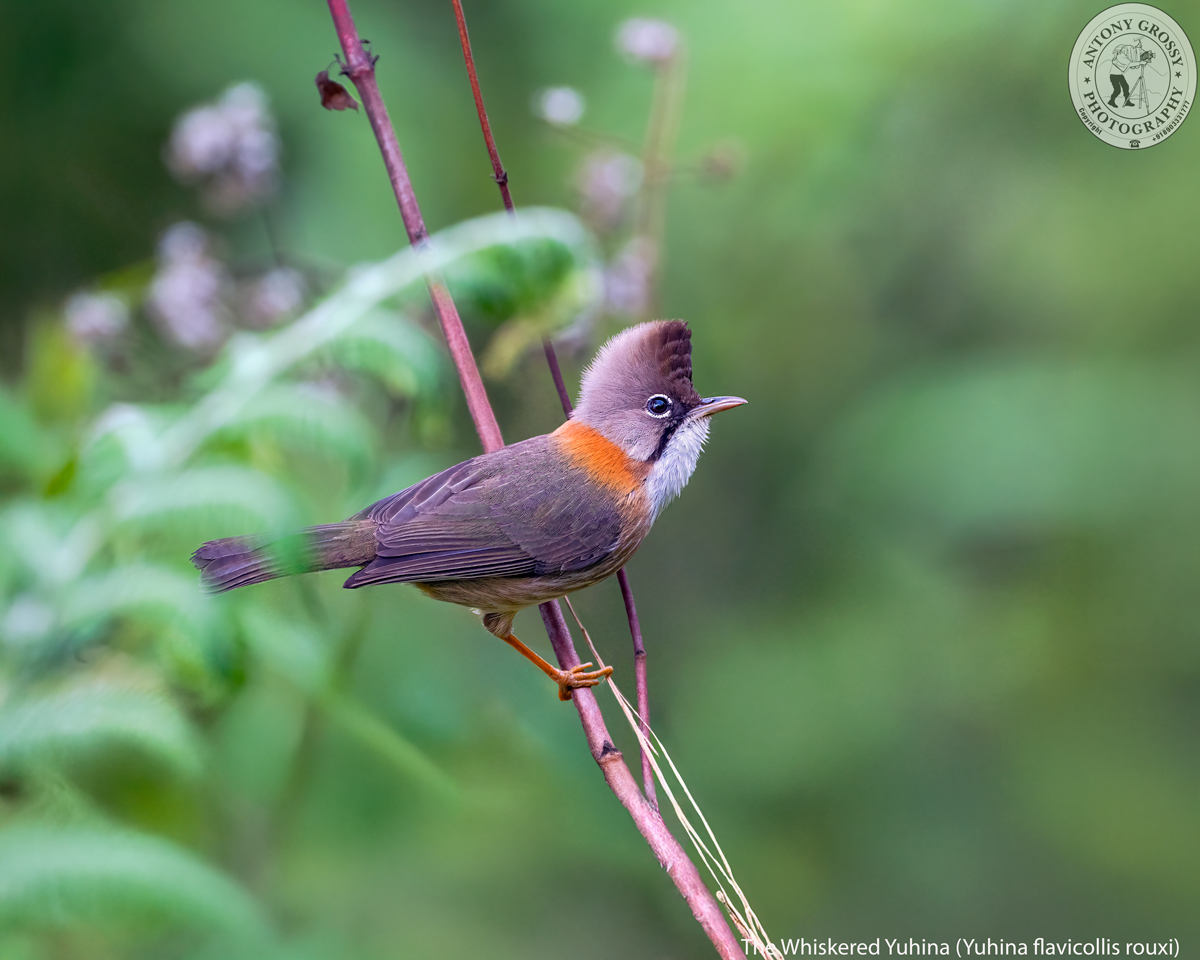

|
 |
| The Whiskered Beauty of the Canopy – The Whiskered Yuhina |
| The Whiskered Yuhina also known as the Yellow-Naped Yuhina, is a cute distinguished-looking small songbird with a brown mohawk of a crest. Brown above and white below with an orange nape and a small black mustache stripe. Slender white eye crescents give it a spectacled appearance on top of a whiskered one. Their plumage exhibits an array of colours ranging from olive green to reddish-brown, enabling them to camouflage seamlessly within their natural surroundings. Like other Yuhinas, a very social bird, often seen foraging in the lower and middle levels of hilly broadleaf forests, sometimes with other species. . . . . . …. ………….. ……………….. .. …. …. ……….. … …. ……….. … …. ………… ………….. ………… ………… ….. ………. …………. …….. ……………. …… …. …. ……….. … …. ……….. .. ………… ….. ………. …………. …….. ……………. … The Whiskered Yuhina is a mid-sized Yuhina with grey head and crest, golden-yellow hindcollar, black moustache and yellowish-white underside. It measures between 12 to 13.5 cm in length and weighs about 10 to 19 gms. The Nominate race has elongate and erectile crown feathers brown, lateral feathers behind eye, including supercilium, pale greyish brown, upper nape pale brownish grey, lower nape and neck side rufous, shading to golden-yellow on hindneck, and fading into yellowish-grey-tinged olive-brown on upperparts; upperwing and tail darker brown; lores blackish brown, this colour rising over eye and linking below with blackish-brown submoustachial stripe (broken near bill base); ear-coverts slightly glossy silvery brown; chin and throat white with narrow brown shaft streaks, breast washed yellow (fades on museum specimens) with narrow brown shaft streaks, belly washed yellow, breast side and flanks dull buffish olive-brown with long white streaks, vent as flanks but without streaks; iris red-brown to dark brown, prominent broad white orbital ring broken at front and rear; upper mandible horn-brown to dark brown, lower mandible flesh or pinkish brown to steely greyish; legs yellowish to fleshy-brown. The Sexes are similar. Juvenile lacks streaking below, and colour of nuchal collar indistinct. There are Five subspecies currently recognized differing mainly in various aspects of plumage colour of upperparts, underparts, nuchal collar, lateral crown and upper nape, ear-coverts and chest. The Subspecies Rouxi found in hill states South of River Brahmaputra, has slightly darker, warmer-tinged upperparts, more uniform rufous collar, darker breast side and flanks. . . . . . …. ………….. ……………….. .. …. …. ……….. … …. ……….. … …. ………… ………….. ………… ………… ….. ………. …………. …….. ……………. …… …. …. ……….. … …. ……….. .. ………… ….. ………. …………. …….. ……………. … The Whiskered Yuhina range extends across the Himalayan forests in Northern India to North East Indian states, Nepal, Bhutan, Bangladesh and in the East to Indochina including Laos, Myanmar, Thailand, and Vietnam. Its natural habitat is subtropical or tropical moist montane forests. It is found in bush layer and lower storeys of montane broadleaf evergreen forest, oak and open deciduous forest, and secondary growth. It prefers relatively undisturbed closed canopy cover. It is found from 1400 to 3000 mtrs and descending in winter to 500 mtrs, while returning to higher grounds for breeding purposes in spring. . . . . . …. ………….. ……………….. .. …. …. ……….. … …. ……….. … …. ………… ………….. ………… ………… ….. ………. …………. …….. ……………. …… …. …. ……….. … …. ……….. .. ………… ….. ………. …………. …….. ……………. … It eats Beetles, Wasps and other insects, berries, flower nectar, seeds and sugar-rich sap from bark. It is usually found in small parties, often in association with mixed feeding flocks which may contain other small babblers. Forages in lower branches of trees and bushes, sometimes low brambles. Known for their acrobatic feeding behaviour, these birds can frequently be seen hanging upside down while skilfully extracting insects from foliage or sipping nectar from blooming flowers. . . . . . …. ………….. ……………….. .. …. …. ……….. … …. ……….. … …. ………… ………….. ………… ………… ….. ………. …………. …….. ……………. …… …. …. ……….. … …. ……….. .. ………… ….. ………. …………. …….. ……………. … These charming birds possess a distinct melodious call that resonates through forests, creating an enchanting atmosphere for those who encounter them. Song a repeated, shrill, high-pitched tzii-jhu ziddi, with stressed first note and slightly undulating end note; also as twe-tyurwi-tyawi-tyawa. Callsvideo include thin squeaky swii swii-swii and sudden harsh buzzy nasal jhoh, this sometimes preceded by thin high note, fzee-tzzúp. . . . . . . . . . . . . . . . . . . . . . . . . . . . . . . . . . . . . . . . . . . . …………………….. ………………………………………………………………… ………………………………………………………………………………………………………………………………………………………………………………………….. ………………………………. .. ……… …… … …. ……….. Description Credit Birds of the World (The Cornell Lab), Oiseaux, Birda, Animalia, Nepal Desk, Ogaclicks, Birds of India | Bird World, Bird Count India & Wiki. |
  |
|
|






































































































































































































































































































































































































































































































































































































































































